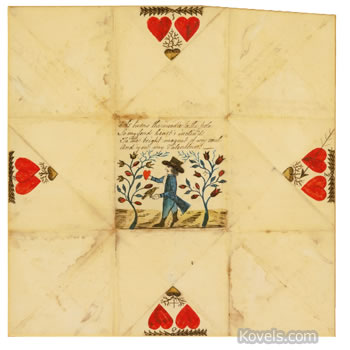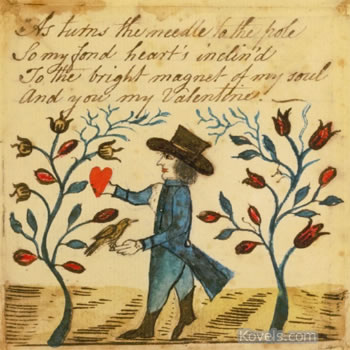Don’t settle for a store-bought Valentine this year. Rediscover the almost-forgotten puzzle valentines that were popular from 1720 to 1840. Sometimes sweethearts in the early 19th century had to work to discover their romantic messages.
A puzzle purse is a square piece of decorated paper that is folded origami-style to form a star, a box or an envelope-like packet or “purse.” It unfolds to reveal a romantic poem or a trinket like a coin, a ring or a lock of a sweetheart’s hair. Sometimes the folded squares are numbered to help the recipient find the message. An original 12 1/2-in. square puzzle purse, circa 1790-1810, auctioned for $6,250 at Sotheby's in January 2014. When folded, the double hearts on the ends are nestled together. A poem is inscribed in ink in the center square. Photo is courtesy of Sotheby's.
Antique paper puzzle purses are very fragile and may be damaged if refolded. A lucky find would be a puzzle with its matching envelope, even rarer and more expensive than a puzzle purse alone.
Other handmade Victorian puzzle valentines have been forgotten over the years. The Internet has made it possible to find instructions and pictures to make similar puzzle purses and puzzles like these:
- Acrostic valentines are decorated with verses that spell out a secret love message using the first letter of each line.
- Rebus valentines had text or a poem that included pictures in place of some words. The word “heart” was represented by a picture of a heart or the word “hear” might be represented by the letter “h” plus the picture of an ear.
- Cut paper valentines or “love tokens” are made by folding paper and then cutting it to make repetitive patterns. Round formats were favored by the Pennsylvania Germans and birds, hands and hearts were often part of the designs. Messages were sometimes written round and round on the cut-out.
- A love knot was a drawing on paper or a piece of ribbon that had words written along the loops.
- Pinprick valentines were made by making a series of tiny holes with a pin on decorated paper. The finished valentine looked like lace and was often mounted over a colored piece of paper.
- Theorems are pictures made with stencils. Valentines were made using this technique about 1835.
In the United States, the style did not change to the familiar lacy valentines until 1848, when Esther Howland of Worcester, Mass., started a company—a group of girls—to make valentines. They used layers of imported lace paper, painted silk and lithographed “scraps” picturing birds, hearts and flowers, and joined them together with paper hinges to create three-dimensional valentines with messages glued inside.
Find prices of valentines and other paper greeting cards in the free online price guide at Kovels.com.
And Happy Valentine's Day!





Leave a Reply
You must be logged in to post a comment.